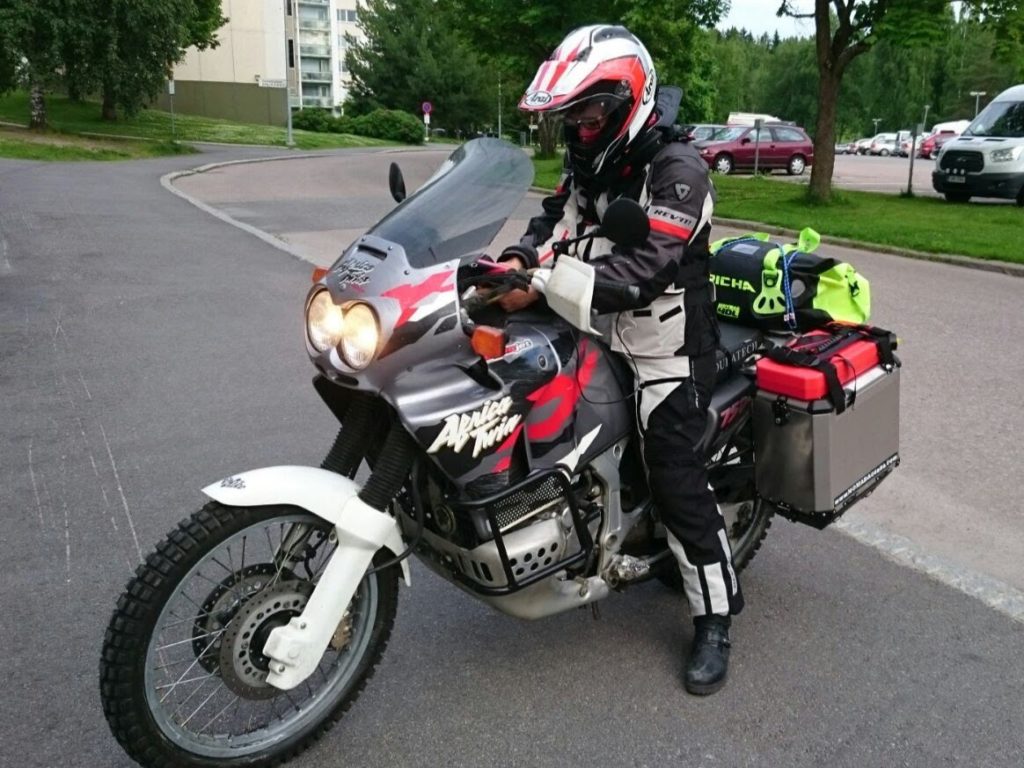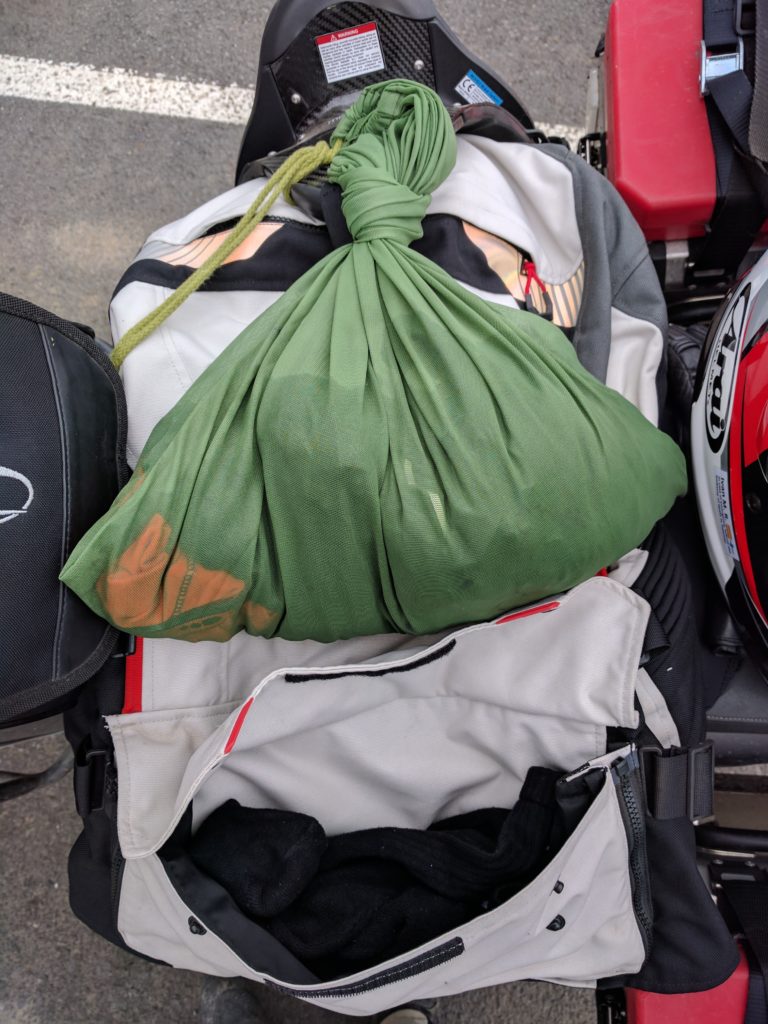It took me long to prepare this post about my Icelandic trip. I thought it would be useful for others to share a detailed list of all the stuff I carried with me. It was my first long trip, so I had no idea of what I was going to need and made the list by guessing and asking people. I obviously ended up missing many things, and carrying many more that I didn’t need.
Unfortunately I didn’t have any proper gear or many of the things I needed, so I had to buy them for this trip. The good side is that I can tell you what I paid for almost every item.
I have divided the list in sections to make it more manageable, and I include comments based on my experience. Those items I don’t make comments about, it’s because they served their purpose and I was happy to carry them.
Motorcycle gear

- Sidi Adventure Gore-Tex boots (317 €).
- Revit Defender Pro GTX jacket (666 €).
- Revit Defender Pro GTX trousers (450 €).
- Revit Strapper suspenders (35 €).
- DZ Hardware tube scarfs, 3 units (15 €).
- Arai Tour-X 4 helmet (550 €).
- Moveo Neck Brace Carbon (333 €).
- Revit Neck Brace Connection Kit II (7 €).
- Revit Zoom H2O gloves (80 €).
I made quite an investment in good gear, but I think it was worthy. I’m not going to repeat what you will read in most reviews in the Internet. My only complain about the Sidi boots is that the plastic doesn’t protect the spot where I touch the shifter, closer to the tip. The leather is getting worn there, so I bought a cheaper pair of enduro boots for my day trips.
I can’t tell whether the neck brace was worthy, I only saw one rider wearing a much smaller model. I wore it attached to the jacket with the connection kit. This made the jacket bulky and slightly more difficult to put on and off. It’s one of those things you better never really need.
I hope I find the time to write a post about all my gear some day, then I could tell you more.
Clothes
- Thin wool sweater
- The North Face Exploration Convertible trousers (50 €).
- Domyos polyester T-shirts, 5 units.
- Nike DF Essential Half Tight shorts, 3 units (84 €).
- Underpants (2 units)
- Puma Sport Crew socks, 5 pairs (10 € for 6 pairs).
- Bula merino wool tube scarfs, 3 units (75 €).
- Trangoworld thin raincoat (Bought it years ago, I think it was around 100 €).
- Adidas Gore-Tex Trekking boots (Bought them years ago, I think they were around 150 €).
Here is my first big mistake: I was warm with the motorcycle gear, I was warm sleeping in the bag, but I was freezing in the morning and evening with these clothes. It was July and I needed, at least, a better sweater.
A friend told me that I only needed three changes of clothes; I took five, and he was right. The thing is that it’s very difficult to dry your clothes in the Icelandic humid weather, specially during the night. So you better have just one change of drying clothes per day, meaning that you must wash yesterday’s clothes every day. Thus, you don’t need more than three changes.
Another good advice from the same friend was to use gym tights as underpants. That way you can change your trousers out of the tent without being in underwear. There had been occasions in which I had to stop anywhere and take my motorcycle trousers off to put or remove the Gore-Tex layer.
I didn’t use the merino wool tube scarfs. The cheap tube scarfs that I had for riding were enough.
Camping
- MSR Mutha Hubba NX 3 tent (469 €).
- Terra Hiker Sand tent pegs, pack of 12 (10 €).
- HelSport Alta sleeping bag (139 €).
- Exped Airmat Lite 5M matress (70 €).
- WellPur Volda pillow (10 €).
- Small broom and dustpan set (2 €).
- Head torch (5 €).
- 20 meters of 2 mm rope (9 €).
- Set of 12 clothespins (1 €).
- Viltpose Småvilt 75×50 net bag (5 €).
If you are riding a motorcycle, you want to keep your gear out but protected from rain. Mine did the job, but a smaller tent with a bigger vestibule would have been better.
The broom and dustpan were a recommendation to keep the tent clean. It was useful, but bulky to carry despite it was a small hand set. I’m not sure if I would take it again.
The rope did its job to hang the clothes, but now I think I should have taken something shorter and stronger that I could also use to pull the motorcycle in case I needed it.
I used the bag to carry my wet clothes, hanging in my back from my neck brace. Quite useless for drying them, but at least they stayed ventilated and the rest of my stuff didn’t get moisted.

Utensils, drugstore products
- Camping cutlery set (4 €).
- Tupperwares. One of 1.8l, two of 1.2l, 5 smaller ones (12 €).
- Roll of 20l plastic bags (1 €).
- Toiletry bag (8 €).
- Mirror (2 €).
- Soap bar (3 €).
- Wet wipes, 2 packs (4 €).
- Personal hygiene items.
- Washing machine bag (2 €).
- Insect repelents and kill sprays (26 €).
- Antihistamine and painkillers.
I only needed the three bigger tupperwares. The roll of plastic bags and the soap bar proved to be very useful, I used the later to wash myself and my clothes. The washing machine bag was an alternative when I didn’t know what to do with my wet clothes, but I only used the other bag. I often got my hands dirty, the wet wipes were very useful but I only needed one pack. I also took too many medicines. Insects are an issue in Finland but not in Iceland; I left the repelents and kill spray in a guesthouse during the trip because they were just a big waste of space.
Trekking gear
- Phoxx 8×21 binoculars (20 €).
- Sharek 1 liter flask (16 €).
- Silva 10 Carabiner compass (12 €).
- MacKenzie telescopic aluminum walking sticks (30 €).
- Phoxx self-inflating cushion (15 €).
- Leatherman Wave multi-tool (100 €).
- Sea To Summit Nylon Tarp-poncho (46 €).
I was planning to do some several-hours trekking some days, but at the end I never had that much time and I chose to ride the motorbike to places instead. I only used the binoculars and the flask.
No matter how you plan to travel and what you plan to do, binoculars are a must in Iceland. They will give you a better view of mountains, glaciers, cascades, birds…
I used the flask to carry water when riding. At the beginning I also carried a 1.5 liter bottle, but 1 liter is enough to make it to the next free source of water. Actually, considering the temperatures, I didn’t really need a thermo flask. A plastic bottle would have been enough.
I didn’t use that compass, but I still want to fit a compass in the motorbike in a place where I can always see it. It would have been useful when my phone broke and I didn’t have GPS.
Electronics
- Google Nexus 5X phone.
- Xiaomi Yi 4K action camera with waterproof case (290 €).
- Sandisk Extreme 64 Gb memory card (36 €).
- iSHOXS Xtension Neo L 38 cm camera mount bar, 2 units (40 €).
- Action camera mount clamp for handlebar (21 €).
- PG Professional 18mm spring clamps, 4 units (5 €).
- Koss KSC32i earbuds (30 €).
- Casio W-800H watch (35 €).
- Kobo Aura One e-reader (245 €).
- Wall USB charger with two ports (25 €).
For a long time I considered taking my older phone as well, for back-up. At the end, I didn’t because I thought that the odds of the new one breaking were minimal. And, in the middle of the trip, the Google phone started failing until it stopped working. I think it was because of me taking pictures under the rain, together with the humidity of the night. The phone was moisted every morning. I later discovered that my sleeping bag had an inner pocket, I should have kept the phone there. In any case, having no phone means no GPS, no Internet, no way of calling emergency services; it really made travelling difficult and risky. Next time I will definitely have a second phone.
Transferring 64 gigabytes from the camera to the phone over WiFi is slow, and so is uploading the videos to the cloud. I had to delete many of the videos I took, just to make space to record new ones. I still haven’t figured out a good solution for this.
The camera bars and clamps were meant to mount the camera in the motorbike in a way I could record myself driving, but I couldn’t find a way that made me confident that I wasn’t going to loose it. So I just used a small mount that comes with it, stuck on top of the visor of my helmet.
The earbuds were for listening to music under the helmet, but it takes many attempts to put the helmet on without them falling off. I wanted to buy a Sena 10C EVO bluetooth system, but it didn’t reach the market before my trip. The watch was useful, specially when I had no phone.
The e-reader was good for the tedious 48-hours ferry trip between Hirtshals and Seyðisfjörður, but I didn’t have much time to kill the rest of the trip.
Motorcycle spares and accesories
- MTX Tools toolbox (119 €).
- Bahco 4750FB5A toolbag (20 €).
- Nordsafe 1kg fire exntiguisher (13 €).
- Kryptonite Kryptolok Series 2 Mini-7 lock (45 €).
- Fixit Tools 20 bungee cords set (13 €).
- Cable ties, 10 units of 540×7.8 mm and 100 units of 98×2.5 mm (2 €).
- Duct tape.
- MC Care P3 tyre repair (6 €).
- Complete set of spare lamps (18 €).
- Complete set of spare fuses (8 €).
From the toolbox, I only took the tools that fitted the bolts and screws of the motorbike. They fitted nicely in the toolbag.
The fire extinguisher was a safety measure when I thought I was going to carry 10 liters of gasoline in external containers. But that didn’t happen, so it was a rather unnecessary weight. I didn’t see a extinguisher in any other motorbike.
The lock is perfect for locking the helmet to the handlebar. Maybe too much for a country like Iceland, but something I still use at home.
I used the bungee cords to strap a bag to the rear rack, and now and then for other things. I think it’s worthy to carry a set of different sizes, they are handy.
The cable ties and duct tape were for emergency repairs. As you know, the former served their purpose. Fortunately I didn’t need the tyre repair. I was often in lonely roads far from any town, it could have saved me in a bad situation.
Considering my motorbike has double headlight, I think I shouldn’t have taken any spare lamp. I could have managed with any broken lamp until the next shop. The vibrations and bumps could have easily broken any of the spares. I didn’t need a new set of fuses either, I later learnt that the bike had spares and where they are located.
So, enough about the preparations. From the next post, I will finally start telling you the actual trip.
